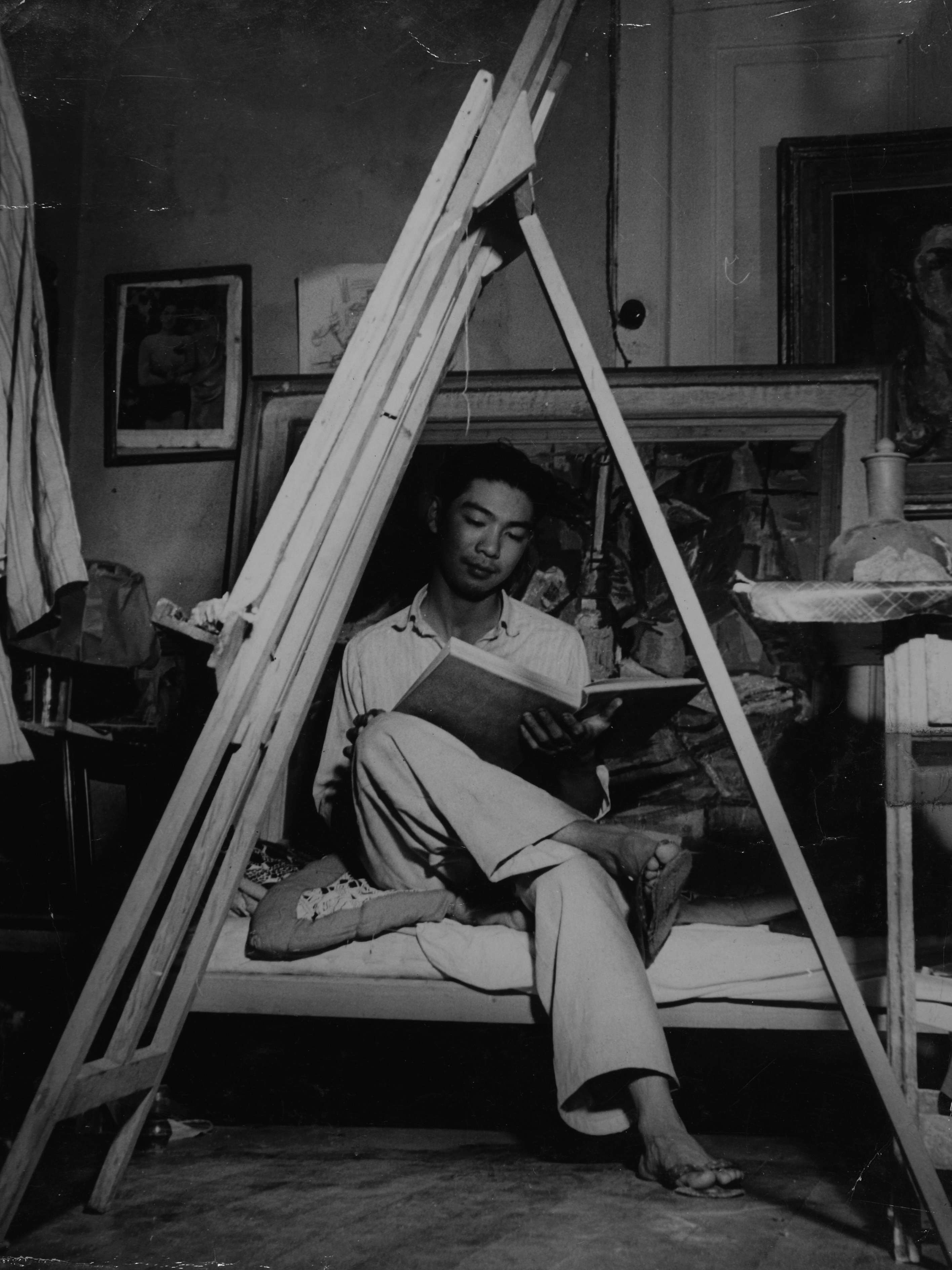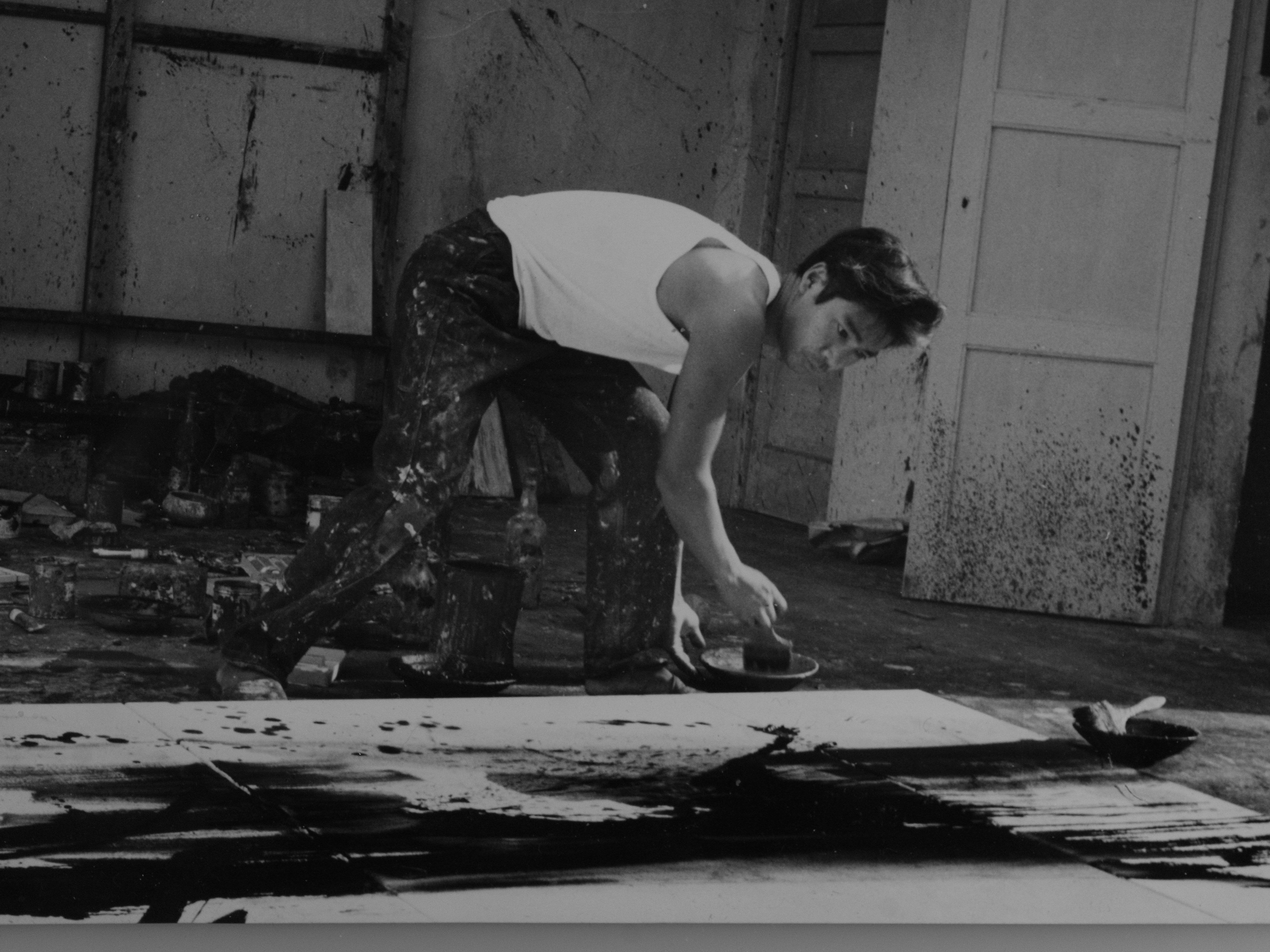
Flavio-Shiró (right) with Inimá de Paula, Rio de Janeiro, 1949

Flavio-Shiró in Santa Teresa, Rio de Janeiro, around 1950

Flavio-Shiró in Pituba, Bahia,1960

In his studio in Paris
Paulo Herkenhoff, Rio de Janeiro 2018
Born in Japan, raised in Brazil and maturing in France, Flavio-Shiró is a rare figure, both as an artist and a human being. He is one of the most cathartic painters active in Brazil and one of the few to use his work to transmit concepts on art and ideas concerned with the human condition.
Miguel de Almeida, Rio de Janeiro 2008
Flavio-Shiró sometimes describes himself as a banyan tree with roots in three continents: the Japan of his origins and family traditions, Brazil, and France. The light of Brazil and of France imbue his painting, one vertical and penetrating, at times blinding, and the other soft and caressing. His work is influenced by these multicultural influences, always mysterious, nuanced, and full of transparency and multiplicity.
Vera Pedrosa, Paris 2007
Flavio-Shiró’s genius as a painter is in his ability to reconcile the figurative and the abstract. The artist succeeds in exploiting the strengths of both Oriental and Western traditions, without subordinating one to the other… As if invoking enigmatic figures from humanity’s collective subconscious, he allows his forms to represent archetypal tales of emotion, movement, and universal transitions.
Nancy Shalala, Tokyo 1993
Flavio-Shiró’s art is motivated by abyssal depths, the opposite of playfulness, entertainment, and pleasure, transforming itself more than ever into a pursuit of knowledge, understanding and mastering of reality.
Olívio Tavares de Araujo, São Paulo 1985
Flavio-Shiró confronts the canvas as a living being. Before applying his alchemy of textures to the canvas, he likes to rumple it, to get it dirty. He superposes layer upon layer, gesture over gesture, until the canvas becomes corrugated, an open sore. For all those accustomed to the generally aseptic art of the Japanese, Flavio-Shiró’s painting upsets, disturbs, and disorients. It is not an appeasing, decorative painting; it is no rainbow. It is painting that requires reflection.
Federico Moraes, Rio de Janeiro 1986
For many artists, the gesture, the pulsating line, gets bogged down in the quicksand of repetition and disembodied symbols. With Flavio-Shiró, the gesture is irrigated by wild streams of myth and never ceases to flower in a broad, green, and live cosmogony, a tapestry in which each thread is a scream, a coupling, a birth, a duel of giants, as it was there in this Amazon real and dreamt, where snake and flower, day and night, breast and hungry ant, death and life, endlessly interwine and voluptuously destroy each other.
André Laude, Paris 1983
…Nightmare and primeval chant, the world of Flavio-Shiró is indefinable and disturbing. It is necessary to master it so that it can contribute to the knowledge of those who look at it. An occult Odilon Redon floats amidst the splendour of these colours so impregnated with palpable dreams that they transform the texture of the painting, giving it magical substance.
Jacques Michel, Paris 1983
Flávio-Shiró… belongs to the family of Goya, Soutine, and Bacon: he is moved by a dramatic, even tragic, feeling which causes him to strip shapes from any complacent appearance and to submit them as the spoils of a relentless inquiry.
Ferreira Gullar, Rio de Janeiro 1981
It is necessary to highlight the fact that, beyond its rhythms and interactions of forces, his work is charged with significant content, with a very fascinating personal mythology where divinities guarding the temples merge at times with extraordinary Amazonian fauna.
Gerald Gassiot-Talabot, Paris 1965
Flavio-Shiró understood that art does not live if not with truth. His painting would not exist if he did not infuse it with his own life, his ideas, his feelings, everything that makes him a man, an artist different from others.
Georges Boudaille, Paris 1962
Without doubt, this impetuous art with its lyrical substance, reflecting thoughts which are equally intuitive and irrational, can be better explained by the atavism of its author than by a philosophical line of thought like Kierkegaard’s. He belongs to an effervescent generation, confronting difficult and even crucial alternatives at this moment of the century. He is called to succeed the splendid flowering of complex and heterogeneous characters like Fautrier and Fontana, Pollock and Dubuffet.
Walter Zanini, Londres 1959
BOOKS
Flavio-Shiró, Edições Pinakotheke, 2018
212 p. ISBN 978-85-7191-103-1
O ano do dragão, Flavio-Shiró
Contra Capa, 2012
96 p. ISBN 978-85-7740-131-4
Promenades au Louvre en compagnie d’écrivains, d’artistes et de critiques d’art
Jean Galard, Edition Robert Laffont, 2010
1278 p. (pp.112-13 p.360)
ISBN: 978-2221106549
Flavio-Shiró pintor de três mundos 65 anos de trajetória,
Instituto Tomie Ohtake, 2008
208 p. ISBN 978-85-88728-10-3
Flavio-Shiró, Miguel de Almeida, Coleção Arte de Bolso,
Lazuli Editora, Companhia Editora Nacional, 2008
127 p. ISBN 978-85-7865-012-4
Flavio-Shiró, Salamandra, 1990
192 p.
